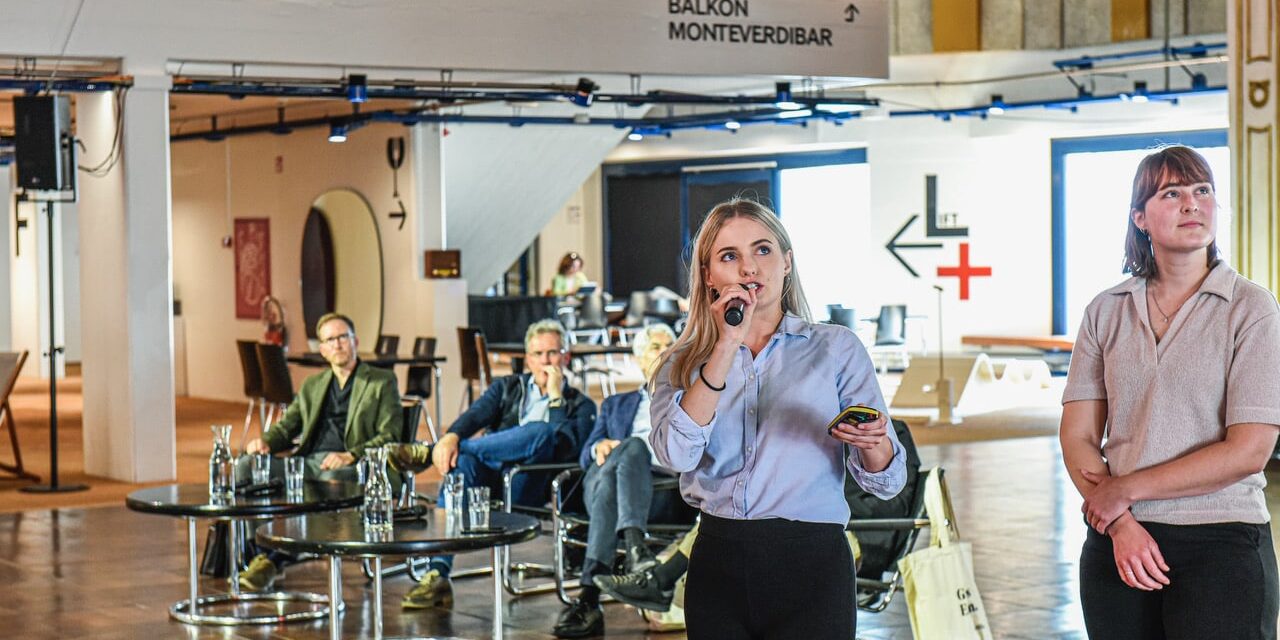Edible city - utopia or necessity?

Are cities the drivers of sustainable nutrition? How high is the degree of self-sufficiency in cities? What goals has the city of Basel set itself and what technologies can help to reduce the consumption of food and water resources?
At the fifth FoodTalk Basel, Lukas Ott (Urban Development BS), Dr. Philipp Urech (ETHZ) and Dr. Christophe Carlen (Agroscope) discussed how food could influence the cityscape of the future in the Public Foyer of Theater Basel during the Open House Days. Michèle Christen and Adrianna Anna Mikos from the Bern University of Applied Sciences presented their project on "Self-sufficiency as an architectural and social opportunity". The afternoon was moderated by Markus Hurschler (Foodways).
Food landscape: A livelihood
Permaculture, aquaponics and vertical farming - planting in the city requires different approaches than in the countryside. As there is a lack of space in the urban context, vertical farming plays a role: by growing upwards, the available areas can be cultivated in a denser way. Adrianna and Michèle showed how buildings could be raised, roof surfaces fitted with solar panels and rainwater collection basins and public spaces used for community gardens. Self-sufficiency also means more cooling, an increase in biodiversity and a better quality of life. Fruit, vegetables and berries would be particularly suitable crops for the city, whereas land-intensive staple foods such as cereals or starchy foods would still have to be grown in the countryside.
Philipp Urech is familiar with urban agriculture from Madagascar. 40% of the food there comes from the immediate surroundings. In contrast to Switzerland, the population of Madagascar is heavily dependent on urban food production. Madagascan cities grow along the major road axes. The space in between often continues to contain rural areas. However, these are coming under pressure due to the growth of the cities. Malagasy farmers are therefore forming coalitions to defend their land against the major shareholders so that the land is not filled up and converted. In Switzerland, on the other hand, subsidies are the political means of choice to make an edible city possible.
Why are cities drivers for a sustainable food system?
Even if self-sufficiency remains an ambitious goal, cities could still achieve a self-sufficiency level of 50-60% and thus make a valuable contribution to agriculture. In addition to urban agriculture, cities influence our food system primarily through consumption, explains Christophe Carlen from Agroscope. Many consumers are located in an urban environment, and their purchasing decisions influence agricultural production accordingly. For example, meat consumption is a major lever: the inefficiency of the meat industry requires significantly more resources and intensifies agricultural areas. If less meat is eaten in urban centers, this land can be used for other foodstuffs, such as the cultivation of plant proteins.
Vertical farming refers to a cultivation system with several layers (7-20 layers). Light is needed between each layer: LED light, which is less energy-intensive than conventional light. The plants grow in water with nutrient solutions instead of soil and therefore hardly need any pesticides, but a lot of fertilizer. Another peculiarity of vertical farming is robotization. Sowing, tending, harvesting and packaging can all be carried out using standard procedures without human intervention. This means 100x more lettuce per square meter than in the field.
Nevertheless, the entire system remains very energy-intensive. Energy is the biggest cost driver and accounts for around half of all expenditure. In an ideal system, the waste heat from LEDs could be used for homes and heating.
The layering makes the vertical more interesting for cities than greenhouses due to the space savings. However, profitability remains a problem. This system is only profitable for fresh produce such as herbs, salads and baby leaves, not for stored vegetables.
Where is the city of Basel headed?
Lukas Ott explains that resource-conserving concepts are needed to reduce the food footprint. The city of Basel promotes systemic and regional thinking, such as the creation of regional slaughterhouses, herb drying plants, in-house fish production, etc. with investment aid. Logistics should be expanded and value chains should be considered, as is the case with energy. Lukas Ott: "If we don't want oil to be a strategic weapon, we need to become more decentralized. The same applies to food."
Lukas Ott explains that resource-conserving concepts are needed to reduce the food footprint. The city promotes systemic and regional thinking, such as the creation of regional slaughterhouses, herb drying plants, in-house fish production, etc. with investment support. Logistics should be expanded and value chains should be considered, as was the case with energy. Lukas Ott: "If we don't want oil to be a strategic weapon, we need to become more decentralized. The same applies to food."